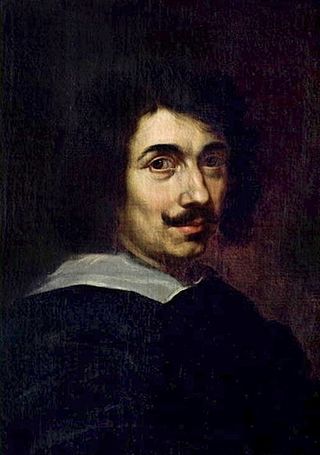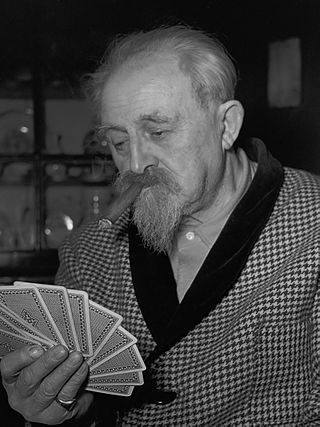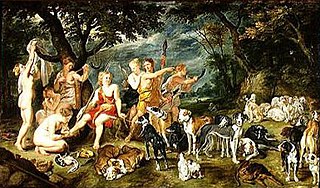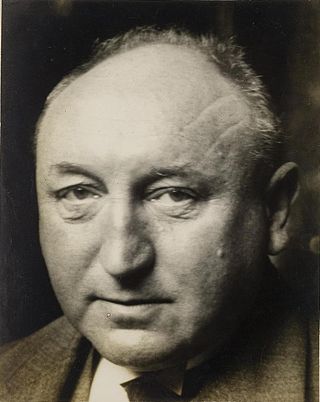Related Research Articles

Jan Brueghelthe Elder was a Flemish painter and draughtsman. He was the son of the eminent Flemish Renaissance painter Pieter Bruegel the Elder. A close friend and frequent collaborator with Peter Paul Rubens, the two artists were the leading Flemish painters in the Flemish Baroque painting of the first three decades of the 17th century.

Claude Lorrain was a French painter, draughtsman and etcher of the Baroque era. He spent most of his life in Italy, and is one of the earliest important artists, apart from his contemporaries in Dutch Golden Age painting, to concentrate on landscape painting. His landscapes are usually turned into the more prestigious genre of history paintings by the addition of a few small figures, typically representing a scene from the Bible or classical mythology.

Giovanni Bellini was an Italian Renaissance painter, probably the best known of the Bellini family of Venetian painters. He was raised in the household of Jacopo Bellini, formerly thought to have been his father, but now that familial generational relationship is questioned. An older brother, Gentile Bellini was more highly regarded than Giovanni during his lifetime, but the reverse is true today. His brother-in-law was Andrea Mantegna.

Color field painting is a style of abstract painting that emerged in New York City during the 1940s and 1950s. It was inspired by European modernism and closely related to abstract expressionism, while many of its notable early proponents were among the pioneering abstract expressionists. Color field is characterized primarily by large fields of flat, solid color spread across or stained into the canvas creating areas of unbroken surface and a flat picture plane. The movement places less emphasis on gesture, brushstrokes and action in favor of an overall consistency of form and process. In color field painting "color is freed from objective context and becomes the subject in itself."

Landscape painting, also known as landscape art, is the depiction in painting of natural scenery such as mountains, valleys, rivers, trees, and forests, especially where the main subject is a wide view—with its elements arranged into a coherent composition. In other works, landscape backgrounds for figures can still form an important part of the work. Sky is almost always included in the view, and weather is often an element of the composition. Detailed landscapes as a distinct subject are not found in all artistic traditions, and develop when there is already a sophisticated tradition of representing other subjects.
Louise Moillon (1610–1696) was a French still life painter in the Baroque era. It is recorded that she became known as one of the best still life painters of her time, as her work was purchased by King Charles I of England, as well as French nobility. Moillon's works show the influence of Flemish painting in their trompe l'oeil effects but are characteristically French in their elegance. Moillon created about 40 paintings during her lifetime which are held in museums and private collections.

Landscape with the Fall of Icarus is a painting in oil on canvas measuring 73.5 by 112 centimetres now in the Royal Museums of Fine Arts of Belgium in Brussels. It was long thought to be by the leading painter of Dutch and Flemish Renaissance painting, Pieter Bruegel the Elder. However, following technical examinations in 1996 of the painting hanging in the Brussels museum, that attribution is regarded as very doubtful, and the painting, perhaps painted in the 1560s, is now usually seen as a good early copy by an unknown artist of Bruegel's lost original, perhaps from about 1558. According to the museum: "It is doubtful the execution is by Bruegel the Elder, but the composition can be said with certainty to be his", although recent technical research has re-opened the question.

Jan van den Hoecke was a Flemish painter, draughtsman and designer of wall tapestries. He was one of the principal assistants in Rubens' studio in the 1630s. He later traveled to Italy where he resided for a decade in Rome. He subsequently worked as a court painter in Vienna and Brussels. Jan van den Hoecke was a versatile artist who created portraits as well as history and allegorical paintings.

Johannes Carolus Bernardus (Jan) Sluijters, or Sluyters was a Dutch painter and co-founder of the Moderne Kunstkring.

Frans Francken the Younger was a Flemish painter and the best-known and most prolific member of the large Francken family of artists. He painted large altarpieces for churches as well as smaller historical, mythological and allegorical scenes. His depictions of collectors' cabinets established a popular new genre of art in the era. Francken often collaborated with other artists, adding figures and narrative elements to scenes created by specialists in landscape, architectural and floral still life paintings.

Roelof Frankot was a Dutch painter.

Sina (Sientje) van Houten was the wife of Hendrik Willem Mesdag, the Dutch marine painter of the Hague School, and a painter herself.

Evert Musch was a Dutch painter.

Diana and Her Nymphs Leaving for the Hunt is a 1623–1624 oil on panel painting by Peter Paul Rubens (figures) and Jan Brueghel the Elder. Diana It is now in the Musée de la Chasse et de la Nature in Paris. During his life, Rubens hoped to encourage the painting of classicist hunting scenes.
Deborah Poynton is a South African painter best known for her monumental, hyper-realistic, hyper-detailed, nude portraits, usually of friends and family. She lives and works in Cape Town.

A Man with Dead Birds, and Other Figures, in a Stable is an oil-on-oak painting by the Dutch painter Pieter de Hooch. It is an example of Dutch Golden Age painting and is now in the National Gallery, London

Matthijs Nicolaas Röling was a Dutch painter, active as graphic designer, wall painter, painter, draftsman, lithographer, pen artist, etcher, and academy lecturer. He is considered a kindred spirit of the 3rd generation of the Dutch Group of figurative abstraction. Röling is described as the "figurehead of contemporary figurative painting in the Netherlands."

Simon Moulijn was a Dutch painter, draughtsman and graphic artist. He was one of the eminent visual artists of his time and became especially well known for his lithographic works.

Simon Willem Maris was a Dutch painter best known as a portrait artist. He was the son of Dutch landscape painter Willem Maris of the Hague School.
Arnold Hendrik Koning (1860-1945) was a Dutch painter. He painted in the style of the Hague School.
References
- ↑ "Zelfportret (1994)".
- ↑ Hartwig, Peter (2005). Peter Hartwig, reflections. Paintings. Assen/Zwolle: [Published on the occasion of the same exhibition at the Drents Museum in Assen]. ISBN 90-400-9059-9.
- ↑ "Peter Hartwig, painter, beeldend kunstenaar". www.peterhartwig.nl. Retrieved 2020-08-04.